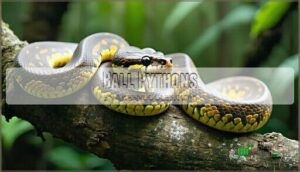This site is supported by our readers. We may earn a commission, at no cost to you, if you purchase through links.

Your typical garden snake might live 10-15 years, but larger species like pythons and boas are built for the long haul.
Their secret weapon? Incredibly slow metabolisms that let them coast through life without burning much energy.
In captivity, where they’re safe from predators and guaranteed regular meals, snakes often outlive many household pets.
Size matters too – bigger snakes generally live longer than their smaller cousins.
The oldest documented snake lived an astounding 62 years, proving these cold-blooded creatures are true survival champions with fascinating longevity secrets and incredibly slow metabolisms that contribute to their ability to live a long life, making them true survival champions.
Table Of Contents
- Key Takeaways
- How Old Can Snakes Get?
- Oldest Snake on Record
- Factors Affecting Snake Lifespan
- Average Lifespan of Common Snake Species
- Longevity of Venomous Snakes
- Lifespan of Aquatic Snakes
- Factors Contributing to Long Snake Lifespans
- Reproductive Maturity and Lifespan
- Oldest Snakes by Species
- Lifespan of Snakes in The Wild Vs. Captivity
- Factors That Can Shorten a Snake’s Lifespan
- Frequently Asked Questions (FAQs)
- How long do snakes live?
- How long do black snakes live in the wild?
- How long do king snakes live?
- How long do ring-necked snakes live?
- How long do captive snakes live?
- What is the oldest snake ever to live?
- Can a python live for 100 years?
- What is the maximum age limit of a snake?
- How old is the oldest snake to live?
- Is there a 30 foot snake?
- Conclusion
Key Takeaways
- You’ll be amazed by record-breaking lifespans – The oldest documented snake lived 63 years, with ball pythons regularly reaching 40-60 years in captivity, far exceeding most people’s expectations about reptile longevity.
- Captivity dramatically extends snake lifespans – Your pet snake can live 40-50% longer than its wild counterparts due to consistent food, veterinary care, protection from predators, and controlled environments that eliminate natural threats.
- Size and species determine longevity potential – You’ll find that larger species, like pythons and boas, typically outlive smaller snakes, with ball pythons averaging 20-30 years, while garter snakes usually reach only 6-10 years.
- Proper care unlocks maximum lifespan – You can help your snake reach its genetic potential through consistent feeding schedules, appropriate habitat conditions, regular veterinary checkups, and stress reduction techniques that prevent common health issues.
How Old Can Snakes Get?
Discovering Maximum Snake Age might surprise you – these remarkable reptiles can live far longer than you’d expect.
The oldest snake on record reached an incredible 62 years in captivity, showcasing Exceptional Snake Longevity that defies common assumptions about reptile lifespans.
Snake lifespan varies dramatically by species.
Ball pythons represent true champions of snake longevity, living over 60 years with proper care.
Meanwhile, garter snakes typically survive 4-5 years in the wild but can reach 10 years in captivity – quite the difference.
Snake Age Extremes depend heavily on environment and species.
Venomous cobras and rattlesnakes generally live 15-20 years, while aquatic giants like anacondas can survive 10+ years.
The Snake Aging Process fascinates researchers studying Snake Lifespan Research, revealing how diet, habitat, and predator presence dramatically influence how long snakes live.
Understanding snake age patterns helps us appreciate these incredible survivors.
Oldest Snake on Record
When you’re curious about snake longevity, prepare to be amazed by the official records. According to Guinness World Records, Annie the green anaconda holds the title for oldest living snake at 37 years and 317 days, verified at Montecasino Bird Gardens in South Africa.
However, several snake records suggest even more impressive ages, with a ball python reportedly reaching 62 years in captivity.
Record Verification reveals fascinating Species Comparison data showing how Captivity Impact dramatically extends lifespans. Understanding a snake’s <strong>potential lifespan</strong> is essential for responsible ownership.
While some cases might involve Genetic Anomalies, the Longevity Secrets often come down to consistent care and protection from natural threats.
Here’s what makes these oldest snake achievements remarkable:
- Annie’s snake age represents exceptional anaconda longevity in controlled environments
- The 62-year-old ball python demonstrates incredible snake lifespan potential
- Fossil records show 167-million-year-old snake species existed
- Modern captive snakes consistently outlive their wild counterparts by decades
Factors Affecting Snake Lifespan
You’ll discover that a snake’s lifespan depends on several key factors that can dramatically extend or shorten their years on Earth.
These critical elements include their diet quality, habitat conditions, predator threats, and whether they’re living in the wild or enjoying the safety of captivity.
Diet
Diet plays a starring role in determining snake longevity. You’ll find that proper nutrition directly impacts how long your snake lives, with wild diets differing substantially from captive diets.
Captive snakes, benefiting from consistent care, often exhibit extended lifespans compared to their wild counterparts.
- Prey variety: Diverse food sources provide essential nutrients for ideal snake species lifespan
- Feeding frequency: Regular meals maintain metabolic health and extend snake lifespan
- Nutritional needs: Balanced diets support immune function and cellular repair
- Food quality: Fresh, appropriate prey enhances overall snake longevity
Habitat
Your snake’s habitat directly determines its snake lifespan.
Wild snakes face overcrowding and degraded environments that cut lives short.
In captivity, proper enclosure size, temperature gradient, humidity levels, substrate type, and enrichment needs create ideal conditions.
Different snake species thrive with specific habitat requirements.
Well-designed habitats can double lifespans compared to stressed, inadequate environments.
Predators
Wild snake longevity faces constant threats from predators who view them as dinner.
Your understanding of predator pressure reveals why captive snakes outlive their wild counterparts by decades.
Successful predator avoidance determines snake lifespan more than any other factor.
- Birds of prey target smaller species using aerial attacks
- Mammals like foxes hunt using superior speed and cunning
- Other snakes employ venom as defense against cannibalistic attacks
- Large fish threaten aquatic species through underwater ambushes
Captivity Vs. Wild
You’ll find that captivity vs wild environments create dramatic longevity differences for snakes.
Predation differences and resource availability mean captive snakes often double their wild vs captivity lifespans.
Environmental stressors like temperature extremes reduce wild survival, while veterinary access in captivity addresses health issues.
Captive snakes often require specialized products for care.
This controlled environment maximizes snake lifespan potential, though genetic diversity remains constant regardless of setting.
Average Lifespan of Common Snake Species
When you’re considering getting a pet snake or simply curious about these fascinating reptiles, you’ll find that common species show remarkable differences in their lifespans.
Ball pythons can live over 30 years with proper care, while garter snakes typically survive 4-10 years, and corn snakes usually reach 6-15 years depending on whether they’re in captivity or the wild.
Ball Pythons
When you’re considering ball python longevity, you’ll discover these remarkable serpents can live 20-30 years in captivity with proper snake care.
Their docile temperament and stunning color morphs make them exceptional companions. Some females even demonstrate asexual reproduction capabilities, adding to their fascinating wild behavior adaptations.
Ensuring proper care involves understanding their specific needs.
- Exceptional snake lifespan averaging 25+ years
- Diverse color morphs from albino to champagne
- Calm temperament perfect for handling
- Minimal enclosure enrichment requirements
- Remarkable asexual reproduction documented in captivity
Corn Snakes
Your beloved corn snake can live 15-20 years with proper captive care, making them excellent long-term companions.
These docile serpents with stunning corn snake morphs often get mistaken for venomous copperheads, but their gentle temperament traits shine in captivity.
Wild corn snakes face shorter lifespans due to predators and harsh natural habitat conditions, while captivity extends their snake lifespan substantially.
Providing proper corn snake supplies is vital for their well-being.
Garter Snakes
Garter snakes prove that size doesn’t determine snake longevity.
These adaptable creatures typically live 6-10 years, with habitat impact playing a pivotal role in their snake life expectancy.
Wild threats like predators limit their lifespan to 4-5 years, while captive diets and controlled environments can double it.
Garter variations across North America show remarkable resilience, making them fascinating subjects for studying snake lifespan by species.
Rat Snakes
Rat snakes showcase impressive snake longevity, with Black Rat Snakes reaching 15-20 years in captivity when you provide proper care.
Their adaptable nature and diverse habitat preferences make them resilient survivors. Wild populations face shorter lifespans due to predation and environmental challenges, while captive specimens thrive with consistent diet specifics and controlled conditions.
- Captive advantages: Regular feeding schedules and veterinary care maximize their potential lifespan
- Wild challenges: Habitat loss and prey scarcity substantially reduce life expectancy compared to corn snake cousins
Regional variations affect snake lifespan considerably. You’ll find the oldest snake records often come from well-maintained captive environments where these remarkable reptiles can truly flourish.
Longevity of Venomous Snakes
You might think venomous snakes live shorter lives due to the dangers they face, but these deadly reptiles can actually surprise you with their longevity.
Cobras typically reach 15-20 years in captivity, while rattlesnakes like Striker have lived up to 34 years, proving that venom doesn’t necessarily mean a shorter lifespan.
Cobras
You’ll find King Cobras living 20-25 years in their natural Asian forest habitats.
These intelligent apex predators primarily hunt other snakes, making their King Cobra Diet quite specialized.
Despite Cobra Venom potency being moderate, their Snake longevity faces threats from Cobra Habitat Loss.
Their endangered Cobra Conservation Status affects maximum Snake lifespan, though Cobra Intelligence helps them survive longer than smaller venomous species.
Rattlesnakes
Rattlesnakes face unique challenges that dramatically impact their snake lifespan.
While these venomous reptiles can live 15-20 years in captivity, wild populations struggle with shorter snake longevity due to human interference.
Three major threats affect rattlesnake aging:
- Habitat destruction disrupting natural Rattlesnake Habitat
- Human hunting for skin trade reducing reptile lifespan
- Vehicle strikes cutting short snake aging processes.
Human activities substantially shorten their natural longevity potential.
Copperheads
Copperheads typically live 15-20 years in the wild, but can reach 30 years in captivity with proper care.
These pit vipers face predation from hawks, owls, and king snakes that substantially reduce their natural lifespan.
| Environment | Average Lifespan |
|---|---|
| Wild | 15-20 years |
| Captivity | 25-30 years |
| Protected habitat | 20-25 years |
Their copperhead venom and defensive copperhead behavior help them survive longer than many snake species in challenging copperhead habitat conditions.
Lifespan of Aquatic Snakes
You’ll find that aquatic snakes face unique challenges that directly affect their lifespans, with species like anacondas typically living 10-20 years while smaller water snakes often reach only 8-12 years in the wild.
These water-dwelling reptiles can’t survive more than a few days without constant access to their aquatic habitat, unlike their terrestrial cousins who adapt better to changing conditions, making their ability to thrive highly dependent on their environment and constant access.
Anacondas
After exploring venomous snakes, you’ll find anacondas present fascinating lifespan patterns in South American swamps.
These apex predators showcase remarkable snake longevity through their unique aquatic adaptations.
While wild anacondas typically survive 10-15 years, captive specimens can exceed 30 years with proper care.
Annie the Anaconda holds the Guinness World Record at 38 years old, demonstrating exceptional snake lifespan potential.
Their massive anaconda size doesn’t guarantee longevity – environmental factors matter more.
These snake species face specific challenges that impact their survival:
- Habitat destruction in wetland ecosystems
- Prey availability affecting nutritional health
- Human interference disrupting natural behaviors.
Their powerful constriction technique helps them survive, but snake lifespan factors like water quality and territory protection ultimately determine how long these magnificent serpents thrive in their aquatic homes.
Water Snakes
Unlike their massive anaconda cousins, water snakes are smaller aquatic reptiles you’ll spot in rivers, lakes, and wetlands across North America. These semi-aquatic hunters typically live 5-10 years in the wild, though their snake lifespan depends heavily on water snake habitat quality and predator pressure.
Captive snakes often benefit from optimal care and nutrition, potentially extending their lifespan. Water snake behavior includes diving for fish, frogs, and small mammals.
Their conservation status varies by species, with some facing habitat loss. Water snake predators like birds of prey and larger fish constantly threaten survival, while their water snake diet of amphibians keeps aquatic ecosystems balanced.
| Species | Wild Snake Lifespan | Primary Threats |
|---|---|---|
| Northern Water Snake | 8-10 years | Habitat loss, predation |
| Banded Water Snake | 6-8 years | Water pollution, fishing |
| Diamond-backed Water Snake | 7-9 years | Human interference, disease |
Factors Contributing to Long Snake Lifespans
You’ll find that snakes can live remarkably long lives when specific conditions align perfectly in their favor.
The key factors that contribute to exceptional snake longevity include a consistent food supply, protection from predators, and proper care in captivity settings.
Consistent Food Supply
Regular feeding regularity acts as the foundation for snake longevity.
When you maintain a consistent food supply, your snake’s nutritional needs are met, promoting healthy gut health and extending snake lifespan.
Here’s how food availability impacts longevity:
- Feeding frequency prevents metabolic stress and supports immune function
- Prey variety guarantees balanced nutrition for healthy organ development
- Food quality directly influences growth rates and disease resistance
Lack of Predators
When predators aren’t constantly hunting them, snakes can focus their energy on growth and longevity rather than survival.
This habitat security dramatically extends snake lifespan compared to high-predation environments where camouflage success becomes life-or-death.
Key factors reducing predation pressure include:
- Juvenile vulnerability decreases in protected environments
- Invasive species absence maintains natural balance
- Apex predators create safer mid-level niches
- Geographic isolation limits natural enemies
Proper Care in Captivity
Creating the perfect home for your pet snake dramatically extends their lifespan compared to wild counterparts.
Temperature regulation guarantees the best metabolism, while habitat enrichment reduces stress through climbing branches and hiding spots.
Regular veterinary access prevents common snake health issues before they become serious.
Diet variety with properly sized prey maintains excellent nutrition, and quality enclosure materials and gentle handling techniques complete the foundation.
These snake care tips can double your pet snake lifespan in captivity, providing a significant improvement in their overall health and wellbeing through temperature regulation and habitat enrichment.
Reproductive Maturity and Lifespan
You might wonder if a snake’s breeding habits affect how long it’ll live, and the answer is surprisingly complex.
Most snakes reach sexual maturity between one and four years old, but frequent breeding can actually reduce their overall lifespan by putting extra stress on their bodies.
Age of Sexual Maturity
When you’re wondering about sexual maturity in snakes, you’ll find fascinating species differences.
Most snakes reach breeding age between 1-4 years, but black rat snakes don’t mature until 7-9 years old.
Environmental impact and diet influence play huge roles in this timeline. Well-fed snakes in stable environments typically mature faster than their wild counterparts.
Captivity effects often accelerate this process since captive snakes receive consistent nutrition and protection.
Understanding snake maturity helps explain why some species reproduce earlier than others in snake reproduction cycles.
Impact of Breeding on Lifespan
Once snakes reach sexual maturity, their breeding patterns substantially influence their longevity.
Breeding frequency creates reproductive stress that can lead to lifespan reduction.
Female snakes investing energy in large clutch size often experience shortened lifespans compared to those breeding less frequently.
This energy drain affects their immune systems and overall health.
However, snake breeding isn’t always detrimental to snake lifespan.
Controlled breeding programs actually promote genetic health within populations, potentially extending lifespans through stronger gene pools.
Wild snakes face the choice between reproductive success and personal survival – it’s nature’s ultimate balancing act.
If you’re keeping breeding snakes, monitor their condition closely.
Snake lifespan and breeding success depend on proper nutrition, adequate recovery time between breeding cycles, and stress management for maximal longevity.
Oldest Snakes by Species
After exploring reproductive maturity, let’s explore some remarkable Record Holders that showcase Species Extremes in snake longevity. These Exceptional Cases will absolutely amaze you!
The oldest snake on record was a female ball python at St. Louis Zoo, living an incredible 63 years. That’s longer than most humans work before retirement! But she’s not alone in breaking maximum snake age expectations.
Here are some other snake lifespan champions that demonstrate Captive Longevity:
- Ben, a Columbian rainbow boa, reached 42 years before passing
- Popeye, another boa, lived 40 years in captivity
- Annie the Anaconda holds the Guinness World Record at 38 years
- Chennai, a king cobra, surprised zoo visitors for 18 years.
These examples highlight key Longevity Factors like proper diet, controlled environments, and veterinary care. Different snake species show varying potential lifespans, but captivity consistently extends their natural life expectancy through eliminating predators and ensuring consistent nutrition.
Lifespan of Snakes in The Wild Vs. Captivity
You’ll find that captive snakes consistently outlive their wild cousins by significant margins, with some species living 40-50% longer when they’re protected from predators, disease, and food shortages.
Wild snakes face constant threats like hunting pressure, habitat destruction, and unpredictable weather conditions, while captive snakes benefit from regular meals, veterinary care, and controlled environments that help them reach their maximum genetic potential, allowing them to live longer and healthier lives due to regular meals.
Threats in The Wild
Wild snakes face numerous life-threatening challenges that dramatically reduce their potential lifespan by 40-50%.
Wild snakes battle constant threats that slash their lifespans nearly in half compared to protected captive cousins.
Predators constantly hunt them, while habitat loss and human impact destroy their homes. Food scarcity forces dangerous hunting expeditions, and climate change disrupts their survival patterns.
Natural disasters can wipe out entire populations overnight.
Captivity offers a chance for snakes to live longer, as guaranteed care guarantees a healthier life.
| Threat Category | Impact on Snake Lifespan |
|---|---|
| Predators & Hunting | Constant danger reduces survival rates substantially |
| Habitat Loss & Human Impact | Destroys shelter and breeding grounds |
| Food Scarcity & Climate Change | Forces risky behavior and weakens immune systems |
Benefits of Captivity
Captive snakes enjoy remarkable advantages that dramatically boost their longevity compared to wild counterparts.
You’ll find these controlled environments create perfect conditions for Extended Lifespan through several key benefits:
| Controlled Diet | Veterinary Access | Predator Absence | Stable Environment | Regular Feeding | Climate Control | Disease Prevention | Stress Reduction | Monitoring | Safety | Care Quality |
|---|---|---|---|---|---|---|---|---|---|---|
| Consistent nutrition | Professional healthcare | Zero predation risk | Ideal temperature/humidity | Scheduled meals | Year-round comfort | Early intervention | Minimal stressors | Health tracking | Protected habitat | Expert husbandry |
Snake lifespan in captivity often doubles or triples wild expectations.
Snake lifespan extension occurs because captive snakes don’t face starvation, predators, or harsh weather.
This Stable Environment with consistent Veterinary Access means your pet snake can reach its full genetic potential for longevity, making captivity the ideal setting for maximum snake lifespan.
Factors That Can Shorten a Snake’s Lifespan
While snakes can live remarkably long lives, several factors can cut their journey short, much like how poor lifestyle choices affect humans.
You’ll find that illness, injuries, and chronic stress act as the primary culprits that reduce a snake’s natural lifespan, often preventing these resilient reptiles from reaching their full genetic potential.
Illness and Disease
When disease strikes, it can dramatically slash your snake’s lifespan from decades to mere months.
Infectious diseases, metabolic disorders, and genetic abnormalities pose serious threats to snake health. Parasitic infections weaken immune systems, while poor preventative care opens doors to countless health conditions.
Common culprits include:
- Respiratory infections, stomatitis (mouth rot), parasitic infestations, and fungal skin infections.
Early detection and proper veterinary care make all the difference in maintaining ideal snake health and longevity. Regular monitoring can help identify early signs of illness to ensure proper veterinary care and early detection are key.
Injuries
Physical trauma can slash your snake’s lifespan dramatically.
Bite wounds from feeding mishaps create serious infection risks, while improper handling causes scale damage and broken ribs.
Even minor injuries compromise snake health and longevity without proper wound care and injury prevention measures.
| Injury Type | Recovery Time | Prevention Method | Infection Risk | Impact on Lifespan |
|---|---|---|---|---|
| Bite Wounds | 2-4 weeks | Proper feeding tools | High | Severe |
| Scale Damage | 1-2 sheds | Smooth enclosure surfaces | Medium | Moderate |
| Broken Bones | 6-12 weeks | Gentle handling | Low | High |
| Burns | 3-8 weeks | Temperature monitoring | High | Severe |
| Cuts | 1-3 weeks | Remove sharp objects | Medium | Moderate |
Stress
Beyond physical ailments, stress acts like a silent assassin, slowly chipping away at your snake’s longevity.
Captivity stressors create chronic tension that weakens immune systems and shortens snake lifespan dramatically.
Wild stressors include predator threats and territory disputes, while captive snakes face different challenges.
Common stress triggers include:
- Improper habitat setup with wrong temperatures or humidity levels
- Handling stress from excessive or rough contact during care routines
- Environmental enrichment deficits like inadequate hiding spots or overcrowded spaces
Frequently Asked Questions (FAQs)
How long do snakes live?
Time flies when you’re having fun, but snakes take their sweet time aging.
You’ll find most species live 10-15 years in the wild, though captivity extends this to 20-60 years with proper care.
How long do black snakes live in the wild?
Black snakes typically live 10-15 years in wild conditions.
You’ll find Eastern Rat Snakes averaging this range, while Cottonmouths reach up to 10 years.
Wild survival depends on predators, food availability, and environmental challenges, which can be considered as environmental factors.
How long do king snakes live?
King snakes typically live 15-20 years in captivity with proper care.
While wild specimens average 10-15 years. You’ll find their lifespan depends on diet, habitat quality, and predator pressure in natural environments.
How long do ring-necked snakes live?
Ring-necked reptiles rarely reach remarkable ages in their natural habitat.
You’ll find these small, secretive snakes typically live 6-10 years in the wild, though captive specimens can survive slightly longer with proper care.
How long do captive snakes live?
Captive snakes typically live much longer than their wild counterparts.
You’ll find most species surviving 20-40 years with proper care, while some ball pythons can reach over 60 years in ideal conditions.
What is the oldest snake ever to live?
Time flies when you’re slithering through decades.
The oldest snake ever recorded was a 63-year-old female ball python at St. Louis Zoo, though Ben, a Colombian rainbow boa, lived 42 years before passing away.
Can a python live for 100 years?
No, pythons can’t live 100 years.
You’ll find ball pythons max out around 60-65 years in captivity with excellent care.
Even the oldest recorded python lived only 62 years, making century-long lifespans biologically impossible.
What is the maximum age limit of a snake?
You’ll find that snakes can live surprisingly long lives, with the oldest recorded snake reaching 63 years old. Ball pythons typically max out around 60+ years in captivity with proper care.
How old is the oldest snake to live?
A 63-year-old female ball python at St. Louis Zoo holds the record as the oldest living snake.
You’ll be amazed that she’s still laying fertile eggs without mating, defying typical snake aging expectations completely.
Is there a 30 foot snake?
No confirmed 30-foot snake exists today.
The largest anaconda on record measured 28 feet and weighed over 500 pounds.
While some species can reach impressive lengths, you won’t encounter a verified 30-footer in nature.
Conclusion
Like Methuselah among reptiles, snakes truly defy our expectations regarding longevity.
Understanding how old snakes can get reveals these remarkable creatures can live decades longer than most pets.
Whether you’re considering snake ownership or simply fascinated by nature’s endurance champions, remember that proper care, species selection, and environmental factors all play vital roles.
From garden snakes reaching their teens to record-breaking pythons hitting sixty-plus years, these cold-blooded survivors continue amazing us with their incredible lifespans.
These remarkable creatures can live for many years, and with the right conditions, they can thrive and become a wonderful pet.


















